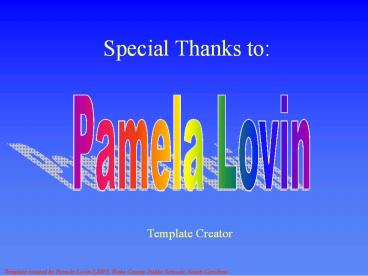Special Thanks to: PowerPoint PPT Presentation
1 / 55
Title: Special Thanks to:
1
Special Thanks to
Pamela Lovin
Template Creator
2
Welcome to
Chemistry
Jeopardy
3
Chemistry
Topic 3 History
Topic 4 Ionic Bonds
Topic 5 Covalent Bonds
Topic 1 The Basics
Topic 2 Conversions
100
100
100
100
100
200
200
200
200
200
300
300
300
300
300
400
400
400
400
400
500
500
500
500
500
Final Jeopardy
4
Topic Area One 100
- QuestionGive an example of a physical property
5
Topic Area One 100
- Answercolor, melting point, boiling point,
density, hardness, malleability, conductivity
6
Topic Area One 200
- QuestionSodium can be represented by the letters
Na. What is the term for the one or two letter
representation of an atom?
7
Topic Area One 200
- Answerthe chemical symbol
8
Topic Area One 300
- QuestionWhat are the three most common states of
matter?
9
Topic Area One 300
- AnswerSolid, liquid, and gas
10
Topic Area One 400
- QuestionWhat term describes measurements that
are close together, whether or not they are
correct?
11
Topic Area One 400
- Answerprecise (as opposed to accurate)
12
Topic Area One 500
- QuestionWhat are two signals of a chemical
reaction?
13
Topic Area One 500
- AnswerEnergy transfer (heat up or cool down),
color change, gas production, precipitate
formation
14
Topic Area Two 100
- QuestionHow many meters is one kilometer?
15
Topic Area Two100
- Answer1000 meters
16
Topic Area Two200
- QuestionHow many kilograms are in 2.04
milligrams?
17
Topic Area Two200
- Answer 0.00000204 kg
- or 2.04 x 10-6 kg
18
Topic Area Two300
- QuestionIf I drink 2.4 L of water and then 550
mL of water, how much did I drink total?
19
Topic Area Two300
- Answer2.95 L or 2950 mL of water
20
Topic Area Two400
- QuestionLead has a density of 11.4 g/mL. If you
have 550 mL of lead, how much mass does your lead
have?
21
Topic Area Two400
- Answerdm/V
- 11.4g/1mLxg/550mL
- 11.45501x6270
- 6270 g or 6.27 kg
22
Topic Area Two500
- QuestionHow many meters per second is 55
kilometers per hour?
23
Topic Area Two500
- Answer55km/hr 55000m/hr 916.67m/min 15.278m/s
- 15m/s
24
Topic Area Three 100
- QuestionWho was the Greek philosopher who
proposed the existence of indivisible,
indestructible atoms?
25
Topic Area Three100
- AnswerDemocritus
26
Topic Area Three200
- QuestionWhose atomic theory stated that an
element is composed of one type of atoms and a
compound is composed of chemically combined atoms?
27
Topic Area Three200
- AnswerDaltons
28
Topic Area Three300
- QuestionWhich piece of Daltons theory did
Thomsons experiment disprove?
29
Topic Area Three300
- AnswerAtoms are indivisible
30
Topic Area Three400
- QuestionWhat part of Thomsons model did
Rutherfords experiment disprove?
31
Topic Area Three400
- AnswerElectrons were distributed evenly
throughout an atom filled with positively
charged material (plum pudding model)
32
Topic Area Three500
- QuestionWhat modification did Bohrs model make
to the pre-existing model of the atom?
33
Topic Area Three500
- AnswerElectrons occupy orbitals with different
energy levels
34
Topic Area Four 100
- QuestionHow does a cation form?
35
Topic Area Four100
- AnswerIt loses electrons
36
Topic Area Four200
- QuestionWhat charge will a nitride ion have?
37
Topic Area Four200
- Answer -3
38
Topic Area Four300
- QuestionWhat is the molecular formula for
magnesium phosphide?
39
Topic Area Four300
- AnswerMg3P2
40
Topic Area Four400
- QuestionWhat is the name of Na3PO4?
41
Topic Area Four400
- AnswerSodium phosphate
42
Topic Area Four500
- QuestionWhat is the formula for cupric nitrite
43
Topic Area Four500
- AnswerCu(NO2)2
44
Topic Area Five 100
- QuestionHow many covalent bonds will hydrogen
form?
45
Topic Area Five 100
- Answer1
46
Topic Area Five 200
- QuestionWhat is the name of the molecule PCl3?
47
Topic Area Five 200
- AnswerPhosphorous trichloride
48
Topic Area Five 300
- QuestionHow many electrons are shared in the
diatomic molecule form of nitrogen?
49
Topic Area Five 300
- Answer6 are shared in the triple bond
50
Topic Area Five 400
- QuestionWhat trait do you use to determine
whether a bond will be nonpolar covalent, polar
covalent, or ionic?
51
Topic Area Five 400
- Answerelectronegativity
52
Topic Area Five 500
- QuestionDraw one structure that a compound with
the formula C2FOH5 could have
53
Topic Area Five 500
- AnswerH3COCFH2 or HOH2CCFH2 among others
54
Final Jeopardy
- Draw the functional group for an alcohol, a
ketone, and a carboxylic acid and write the names
of the smallest molecules for each group (needs 3
functional groups and 3 names)
55
Final Jeopardy
- R-OH, methanol
- R-CO-R, propanone
- R-COOH, methanoic acid

